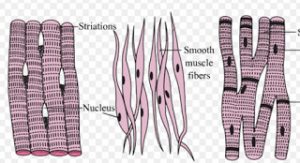Question 1 Name the protein present in muscle fibre? What is its function?
Question 2 Why striated muscles are called as voluntary muscles?
Question 3 What are the functions of striated muscles?
Question 4 What are the functions of smooth muscles?
Question 5 What are the functions of cardiac muscles?
Question 6 What is the location of smooth muscles?
Question 7 Distinguish between Skeletal muscles and cardiac muscle tissue?
Muscular Tissue
They are made up of muscle cell. They are elongated and large size, so they are called as muscle fibre. They contain special protein called contractile protein.
This protein help in the movement of body or limbs by contraction and relaxation. They are arranged parallel to each other so that they can work together.
(a) Striated muscle
They are called as striped or skeletal or voluntary. The entire muscle show alternate dark and light strips and therefore called stripped muscle. They are attached to bones and are responsible for body movement, and therefore called skeletal muscles. These muscles work according to our will, they are called as voluntary muscles. Striated muscles fibres are long or elongated, unbranched, have many nuclei. Each muscle cell is enclosed in a thin but distinct plasma membrane called sarcolemma. These muscles are present in limbs, face, neck, tongue, pharynx, diaphragm.
It help in smooth contraction and movement.
(b) Smooth muscle
They occur as a bundle or sheets of spindle shaped cells. They have single centrally located nucleus in the centre of cytoplasm. Delicate, contractile thread called myofibrils run longitudinally through the cell. They are found in walls of alimentary canal, internal organs, ducts of glands, stomach, bronchi, iris of eyes.
Function
(1) They do not work according to our will, so they are called involuntary muscles. Movement of food in alimentary canal, opening and closing of tubes are involuntary movement.
(2) Help in contraction and relaxation of blood vessels.
(c) Cardiac muscle
They are made up of branched, cylindrical and uninucleate cell. Each cell is surrounded by sarcolemma, has cytoplasm with longitudinal myofibrils, intercellular spaces are filled with loose connective tissue and blood capillaries. They have stripes or light and dark bands. They occur in heart.
Function
(1) They contract and relax rapidly, rhythmically and tirelessly throughout life.
(2) Relaxation and contraction of these muscles helps to pump and distribute blood to various body parts.

i find notes useful
thanks
very good notes
i recommend it to all
Very good mam
very Good